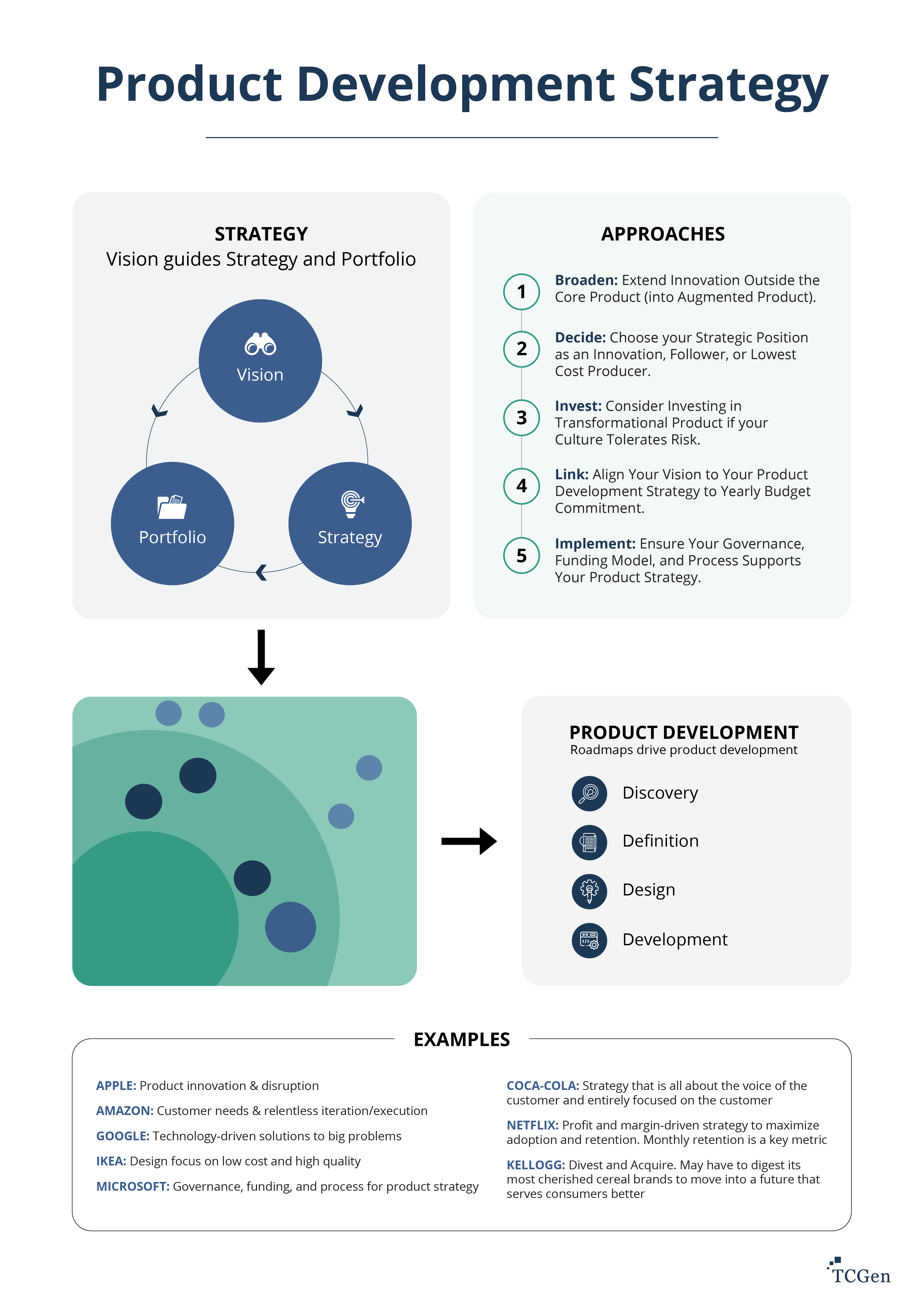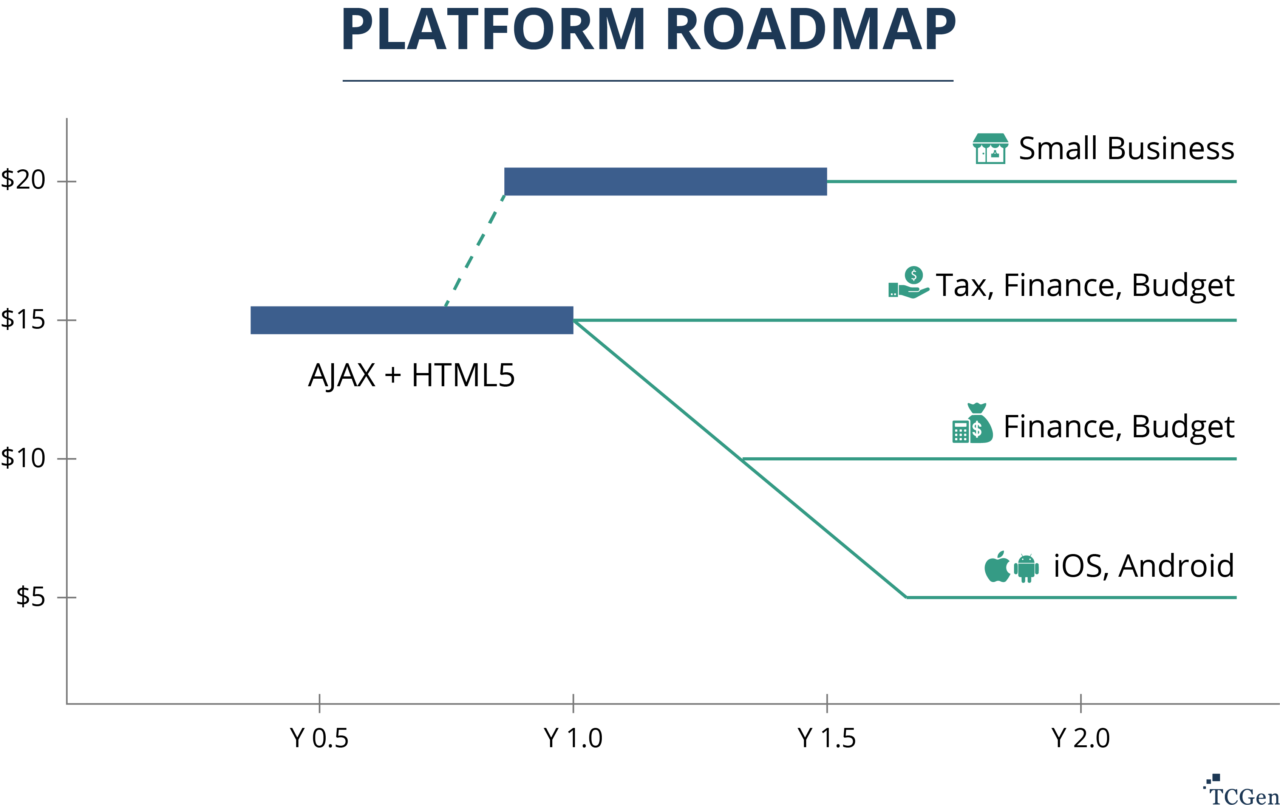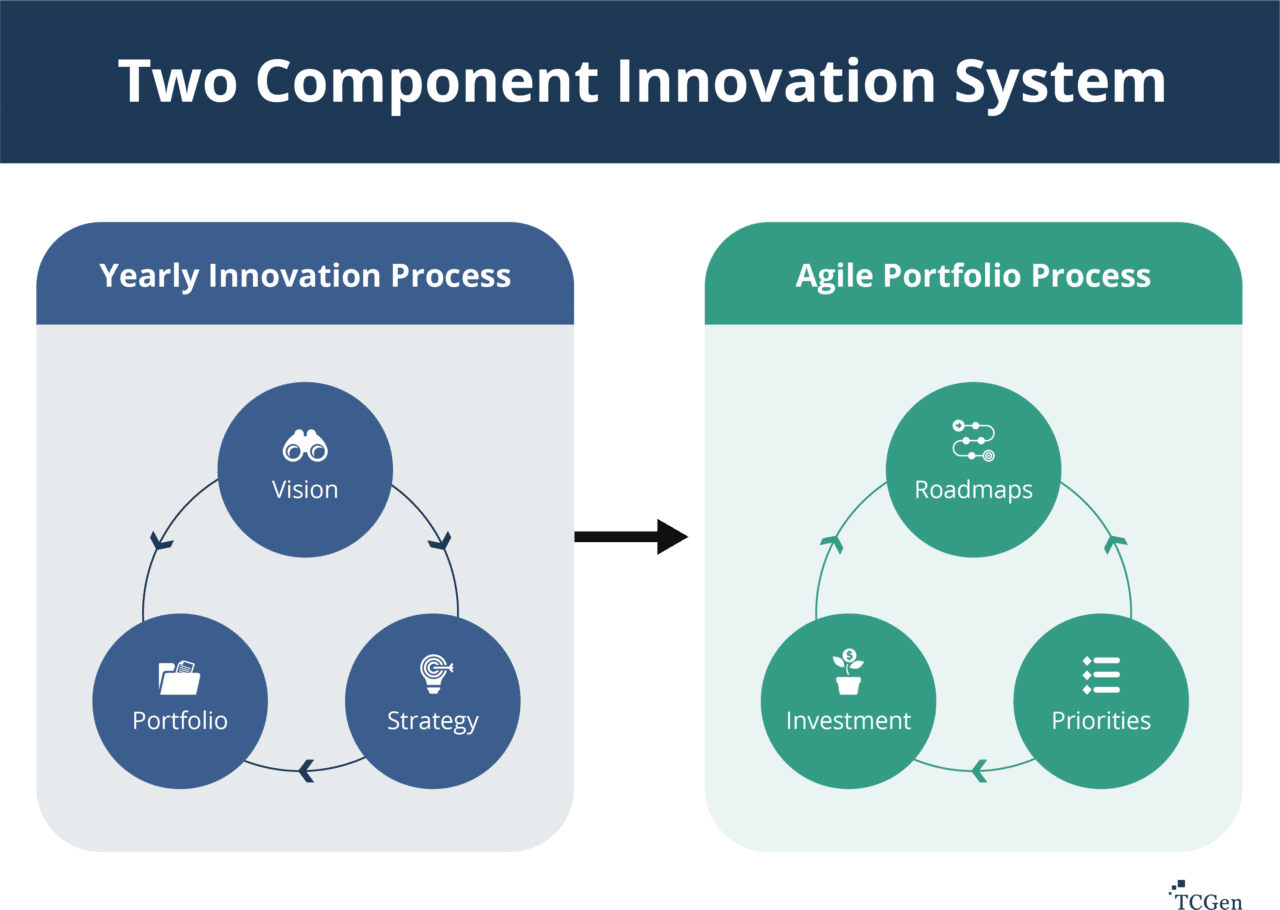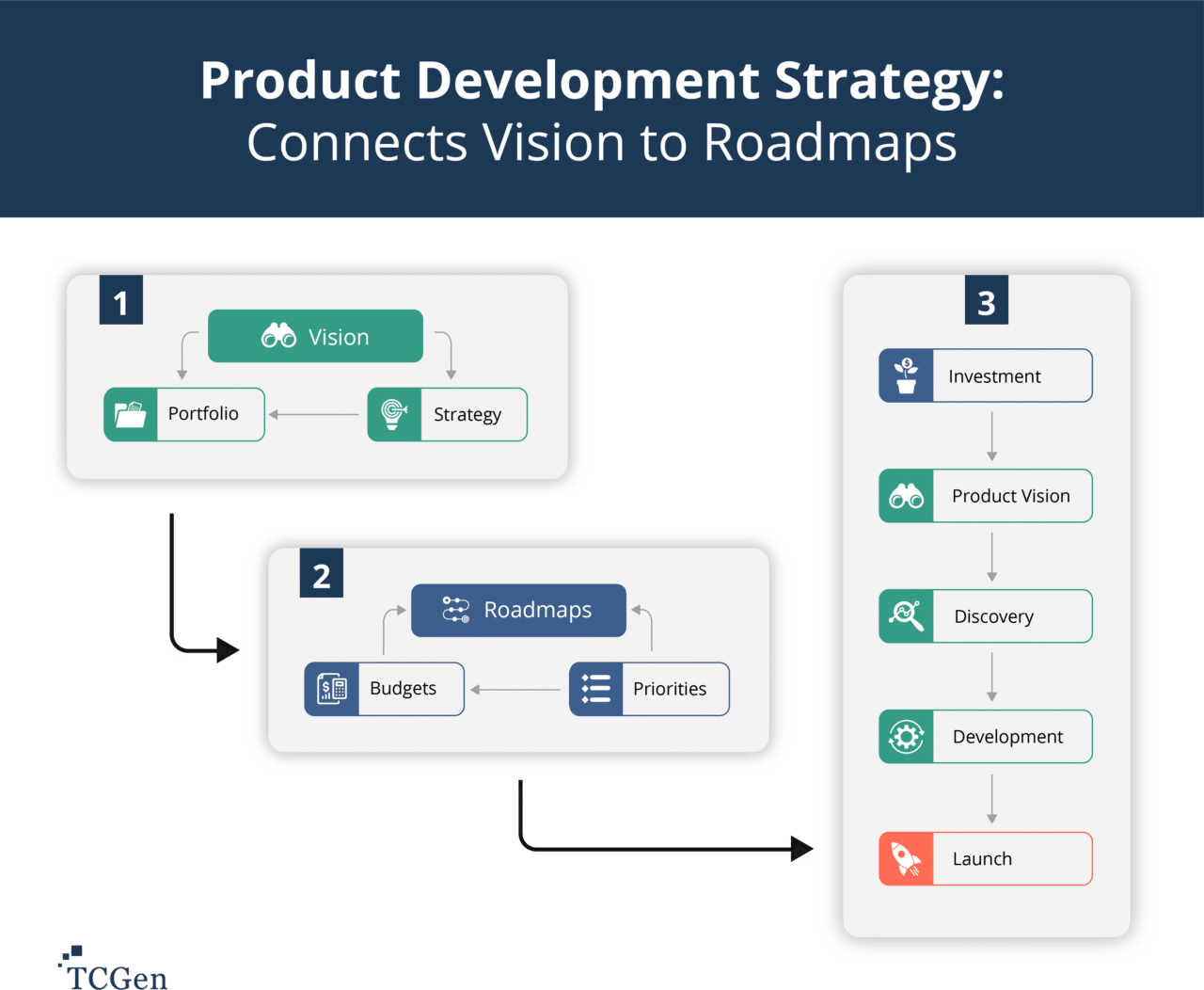What is a Product Development Strategy?

A product development strategy guides new product development or existing product changes to maximize sales.
Product development strategy can be a subset of corporate strategy and should not be confused with the new product development process – it is a lot more. It sets the direction for new products by establishing goals and through funding decisions. Product development strategy aims to gain a competitive advantage by placing product offerings in the best possible position to drive business goals such as sales growth, revenue, and profits throughout the product development life cycle.
TCGen was able to come into a complex assignment and teach both the art and science of project leadership. Seek them out.
–Tood Tomba, Roche R&D Executive
5 Pillars of a Winning Product Development Strategy

Here are the five pillars of a successful product development strategy. There is no correct answer for everyone – pick the one that aligns with your business and start there:
Pricing-driven strategy
A pricing-driven strategy involves adopting a premium or value pricing approach to shape competitiveness and profitability, considering customer preferences and market dynamics.
Innovation strategy
Innovation strategy involves offering the best product or service and determining whether to charge for it or adopt a fast-follower approach.
Time to market strategy
Time-to-market strategy focuses on being first to market with a superior product, emphasizing speed and efficient processes to gain a competitive edge.
Market/Customer-oriented strategy
Market/customer-oriented strategy utilizes customer insights and competitive positioning to drive business decisions, ensuring customer satisfaction and fostering a distinct market advantage.
Platform-driven strategy
Platform-driven strategy optimizes flexibility, cost, and scale through internal approaches, leveraging platforms to create seamless integration, collaboration, and innovation.
Company Examples of Product Development Strategy

Read about how Amazon, Apple, Google, Microsoft, and Netflix developed their tech strategies.
Learn how Coca-Cola, IKEA, and Kellogg use product as an integral part of their corporate strategy in the free downloadable book, or scroll down the page.
Product development strategy examples (Technology)
Amazon’s product development strategy
Amazon is an example of a customer-oriented approach to product development strategy. Their product strategy is focused entirely on customer needs. Amazon likes to work backward from the target market. They write the press release for the product first and hone it until its language is simple enough for anyone to understand. The press release has no technical jargon about technologies or UIs. They then work backward from the press release to the product. This product development strategy focuses on Amazon’s internal process of engaging customers to create a specific product that meets an identified need.
Apple’s product development strategy
Apple is an example of a platform/derivative strategy. They connect their top-level strategy to their product development process. The tech giant tends to be product-driven. Apple creates products and then finds the market for them later. Steve Jobs famously suggested that customers do not always know what they want. Apple bets that customers will pay a premium for superb products and tends to focus on optimizing existing offerings. Apple relies on brand loyalty and is happy to allow competitors to control the market with lower-priced products that compete with Apple’s.
Google’s product development strategy
Google’s new product development strategies tend to be technology-driven. Google bets on technology “to solve a big problem in a big way.” This is a market-oriented approach since Google favors growing the market for everyone, which serves Google as the market leader. Google also optimizes for growth, not for revenue. Google’s product development strategy takes a long view, which is typical of a company with a consistent market leader.
Microsoft’s product development strategy
Microsoft has an exemplary product innovation strategy that is carried out through partnerships. “Our industry does not respect tradition – it only respects innovation,” said Microsoft CEO Satya Nadella. The maturing tech giant began its strategic transformation in 2014. It conceded the smartphone market to its rivals and invested in AI and Cloud. It created an AI division with thousands of engineers and scientists. It also dropped its aggressive ways and began to emphasize partnerships. It embraced open-source software, becoming the leading open-source code contributor by 2017. Microsoft is now unique in offering a discrete product, unlike Google, Twitter, and Facebook, where user data is the product.
Netflix’s product development strategy
Netflix has a Profit and margin-driven strategy to maximize adoption and retention. Netflix is the largest streaming service in the world. Netflix’s core offer is a subscription, which includes unlimited access to content. Its product strategy emphasizes margin growth. Monthly retention is a crucial metric. It has increasingly focused on providing high-quality original content to pin eyeballs to screens. Netflix relies on a robust, trustworthy brand promising “movie enjoyment made easy.” Its strong brand, ease of use, and personalization are difficult for competitors to duplicate.

New Product development strategy examples (Consumer)
Coca-Cola’s product development strategy
Coca-Cola has a strategy that is all about the voice of the customer. “If we embrace where the consumer is going, our brands will thrive, and our system will continue to grow. This is Our Way Forward,” said Coke President and COO James Quincey in 2017. Coca-Cola has become focused entirely on consumers and what they want from beverages. As consumer tastes change, for example, toward options with less sugar, Coke is moving with them. In recent years, Coke has rolled out new products in response to consumer demand, from juices to coconut water to organic tea. Consumers want beverages with benefits. Some call for smaller, more convenient packages than the classic Coke can. Coke’s strategy is to continue to listen to the customers’ voices and respond to them.
IKEA’s product development strategy
IKEA has a strategy to focus on low cost at a consistent level of quality. The high volume of interchangeable parts requires an extensive, worldwide supply chain. Initially, the company leased out equipment to suppliers and provided training to ensure quality. Later, as it became an international brand, it reorganized its supply chain to manage its suppliers’ large volume and geographic dispersion. With its core competency in supply chain management, Ikea can pursue a product differentiation strategy offering furnishings for any home. Ikea also commits to sustainable design principles. Its product strategy relies on intelligent design driven by its unmatched supply chain.
Kellogg’s product development strategy
Kellogg has a strategy of divesting and acquiring. Kellogg may have to divest its most cherished cereal brands to move into a future that serves consumers better. Kellogg’s iconic brands like Corn Flakes, Frosted Flakes, and Froot Loops were the Boomer’s favorite breakfast growing up. However, times have changed, and the cereal market is declining as more consumers avoid sugar and carbs. Following a strategy of acquisition and divestment, Kellogg sold off its Keebler and Famous Amos cookies brands while acquiring brands like RXBAR, which are more health-aware.
How is product development strategy related to new product development?
Product development strategy enables product organizations to create a stream of innovative offerings that disrupt the competition, delight customers, and deliver a compelling value proposition. New product development is often integrated into product strategy to emphasize innovation and support diversification (including development steps specific to new products). Product development can be daunting for entrepreneurial companies, so their approach should be straightforward and oriented toward getting new concepts to market without much investment. Being able to iterate quickly is critical.
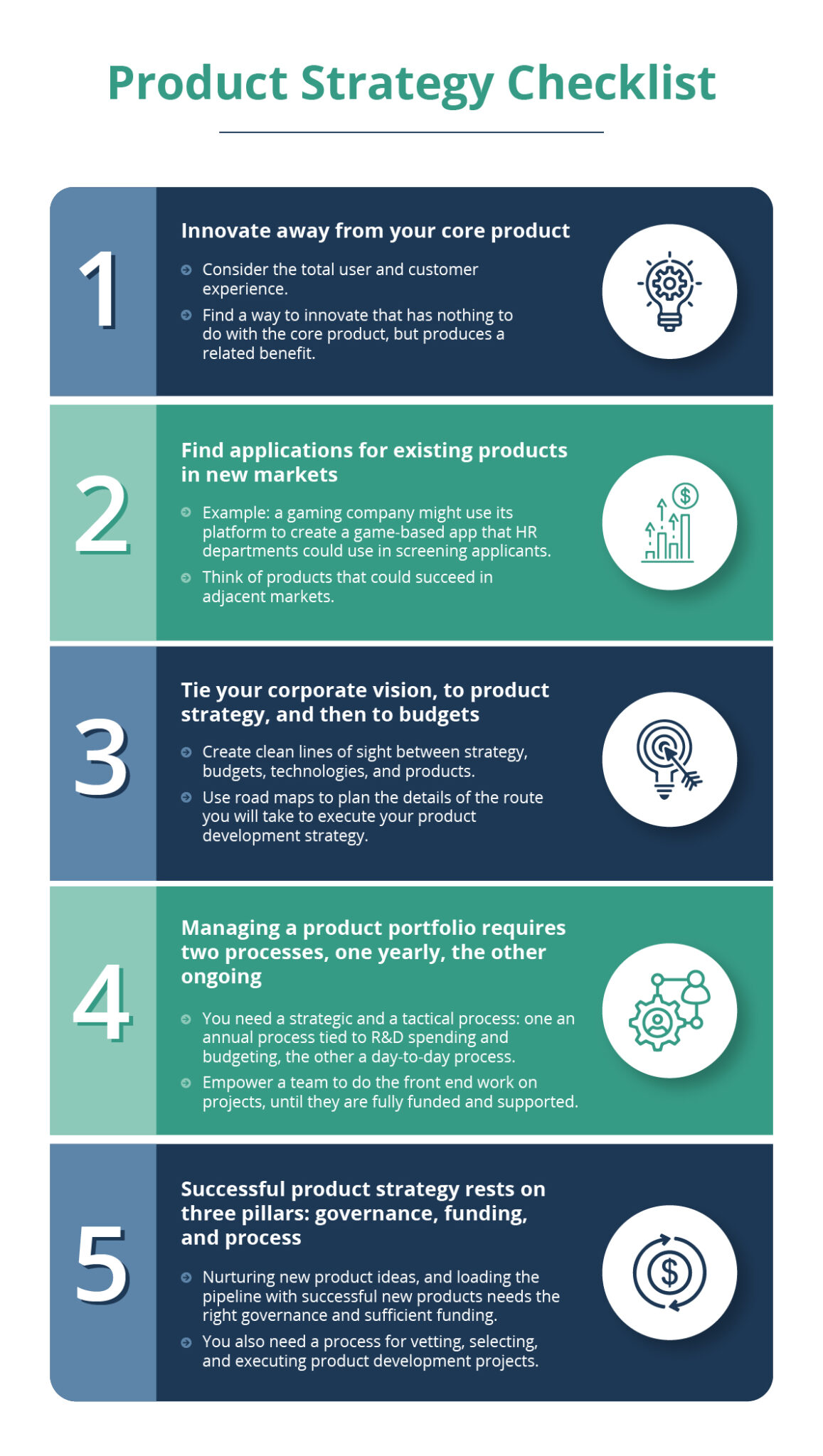
Product development strategy is a subset of corporate strategy. It sets the direction for new products by establishing goals and through funding decisions. Product development strategy aims to gain a competitive advantage by placing product offerings in the best possible position to drive business goals such as sales growth, revenue, and profits.
New product development strategy is the means to…
- Mitigate risk in developing a product concept
- Improve the fit between products and markets
- Overhaul a product line
- Increase the sales of existing products by enhancing them
Although market research and marketing strategy are necessary in most cases, there are other inputs to business strategy. A fully formed product strategy includes your brand, platforms, technology, etc. Often, product management consulting engagements can inform product strategy.
Here are 5 more ideas for a product development strategy:

- Innovate new product/service areas outside your core product
- Clarify your direction: innovator, follower, or low-cost participant
- Establish your product portfolio consistent with risk tolerance and market position
- Tie your corporate vision to product strategy and then to yearly budgets
- Implement proper governance, funding, and process for setting a new product strategy
Product development growth strategy types

Many approaches to product development strategies focus on different dimensions of the new product process (including what to do with existing products) and the product development organization. Most often, product development strategy is driven by three market position categories:
- Premium, innovative, and differentiated products with High Price/High Value (Apple iPhone Pro)
- Competitively priced products that differentiate on minor factors, including pricing (Crest Toothpaste)
- Low-cost products where often the quality is good enough (Kirkland, Costco’s house brand)
The first category above will have the highest product development or R&D expenses – typically in the 10-20% range. The competitively priced strategy is in the 5-10% range, and the low-cost category requires less engineering, and R&D spends are below 5% of sales. Tech product development strategies are expensive, where software companies typically run in the 10-25% of sales spent on development and testing. This is also true of companies that focus on new product introductions. Note that the company’s risk tolerance may come into play here, and often, it is advantageous to take a product portfolio management approach.
Product development strategies either augment those positions or enable them by focusing on time to market, calculating technology and market risk, on a solid platform that spins off families of products, or on customer insights and internal procedures to produce the best existing solution.
Time-based Approach to Strategy
One approach to product development strategy emphasizes when your new product offering enters the market. In this approach, entrants compete on time to market. Either a company is an innovator that creates a brand new product category. It is a rapid follower in that rapid commercialization is the goal, or it lags as a “me too” product.
These three product strategies are often described as:
- First to market
- Fast Follower
- Laggard
The research favors the view that companies that are first to market reap the rewards. There is a strong correlation between innovation and long-term success in creating new products. (One technique commonly used to shorten time to market is an escalation process.)
Innovation in Product Development Strategy: Ideation Process Approach
If your organization has a formal process in the front end of development, you may have a well-conceived and practical strategy. Suppose your product team starts with a formal way to gather customer feedback, tap into focus groups, get input from new customers, perform brainstorming, and get internal stakeholder input. In that case, you have the makings of an implicit product strategy.
Of course, you should start with your market share, demographic segments, corporate strategy, market share by segment, and other factors drawn from your business strategy. But sometimes it makes more sense to start from the current product version, knowing what needs improving from user experience and product functionality feedback, and you can generate an excellent product starting from the known (but always informed by your business strategy).
Even at this stage, it is possible to validate your ideas early – these are likely screenshots or paper prototypes.
Ideation processes can be steered in several variations by filtering concepts. For example, focusing on time to market, on a calculation of technology and market risk, on a solid platform that spins off families of products, or on customer insights and internal procedures to produce the best existing solution can cause you to select one concept over another.
Product Management and the Market-oriented Approach to Strategy
Another common approach to product development strategy is around the dimensions of the target market, target audience (marketing strategy focused), or even driven by a market development strategy. Often, this takes the form of a relative emphasis on technological or market innovation led by product management.
A new product development represents a technological innovation within an existing market, finds new market applications for existing products, or opens up an entirely new market. Product marketing and product management often work together on a market-oriented approach for in-market products.
Research on market-oriented approaches yielded five different types of product development strategies:

- Innovators often leverage their existing resources to create new technologies or introduce new features to existing products that cater to the needs of their established markets.
- Investors in technology, mainly through acquisition or partnerships with other entities (for example, with a university research center).
- Searchers for new markets take existing products and try to find applications for them in new markets. For example, a game design company might sell a game-like app that helps HR test new applicants.
- Business As Usual companies continue pushing existing products to current markets and attempting to compete in price, margins, or distribution.
- Middle-of-the-road companies are happy to take an incremental approach with low or moderate innovation in products and markets and stick more with modifying existing products.
Platform-based Approach to New Product Development Strategy
According to David Robertson and Karl Ulrich, a platform is “the collection of assets shared by a set of products.” A platform then spawns families of derivatives. These families have a relationship with one another concerning cost, performance, quality, or feature density.
For example, in the computer business, 15-inch laptops might constitute a family within a platform of laptops of various sizes. The variants within a family might appear at multiple price points with different feature sets, such as the amount of memory, hard disk size, CPU speed, and graphics capability.
A platform approach to product development strategy represents a way of optimizing innovation. Usually, the platform results from many years of research and development and codifies all the efforts resulting from one or more innovative concepts. A platform’s most significant benefit is that it maximizes an invention’s revenue and business impact by spreading different new product offerings. Frequently, this is best illustrated by showing the relationships between platforms and derivatives in a product roadmap.
When you leverage the significant design work embodied in a platform, your subsequent product variants will require much less engineering time and calendar time to bring to market. Innovation processes become much more efficient by leveraging the know-how from existing products. This also allows you to enter a new target market efficiently by creating a derivative of a product family.
Customer-oriented approach: Design Thinking
Another approach is to focus on the company’s internal process for producing valuable innovations that delight customers, addressing their pain points as a core part of your product development strategies, and breaking away from existing products. The customers’ needs come first in this approach.
Design Thinking emerged from Stanford University and was carried forward by IDEO. Both Stanford and IDEO have templates to get you started if you are new to design thinking.
In the Design Thinking approach to new product creation, companies invest in a deep understanding of the customer. They then convert information derived from customers into successful products in the market through a set of consistent steps.
This approach sees the creation of winning new products as the result of an information processing procedure that includes:
- Product concept generation based on customer insights
- Product planning
- Product engineering
- Manufacturing (or launch) engineering
This approach does not concentrate on what competitors are doing as much as what customers require (market testing helps de-risk). This approach is more customer-facing and is often part of an Agile Product Development process. It puts the onus on an internal process to deliver for customers. However, sometimes, it involves the customer creating a Minimum Viable Product (MVP) for early market feedback (including social media) just before launch. This methodology can apply to existing products, too.
What’s the difference between corporate strategies and product development strategies?
Product development strategy flows from corporate strategy. It is a corporate strategy applied to the product development process. This flow down from corporate to product development must be managed. Otherwise, reactive strategies will result.
A yearly strategic planning process for new products is a tiny facet of your company’s overall strategic plan. The larger strategic plan provides a “north star” that directs and deploys the totality of capital and assets within the company. Managing product concepts is a small but crucial part of this yearly strategic process.
Product development strategy connects to corporate strategy in every possible way: from the technology hub of your company to the core, augmented, and transformational products to distribution channels, geographic segmentation, product launch, etc. It is beneficial for a given cross-functional team to see how their efforts fit into the larger picture.
How Much Do Companies Spend on Research and Development?

A portion of product development strategy relates to budgeting and expenditures. Companies often wonder…
- How much of an investment should companies make in new product development?
- How much should we invest in a new product idea?
- What is the right mix of investments across our product portfolio?
- How should this investment mix change based on our company’s risk tolerance and maturity?
- Should we continue to invest in existing products or their existing target market?
Typically, investments in new product development are grouped according to the risk amount assumed. For example, a company might organize its projects as follows:
- Core products
- Adjacent products
- Transformational products
According to research, a stable company in a mature industry might allocate 70% for core products, 20% for adjacent products, and 10% for transformational products. This is a relatively low-risk approach.
A tech startup might allocate less than one-half of its development investment in core or existing products since the company does not have a large established target market and is willing to absorb greater risk in creating a new product. A startup might have 40% invested in the core, 40% in adjacent, and 20% in transformational initiatives. In all cases, you need to align with your product development process.
What is typical R&D as a percent of sales figures?
R&D spending varies by industry. The site Idea to Value found that in 2018, Tech companies accounted for 31.3% of the world’s reported R&D spend; Pharma and Biotech spent 18.7% of those R&D dollars, while companies making Automobiles and components spent 16.8%. These three industries spent over two-thirds of the world’s combined reported R&D budgets.
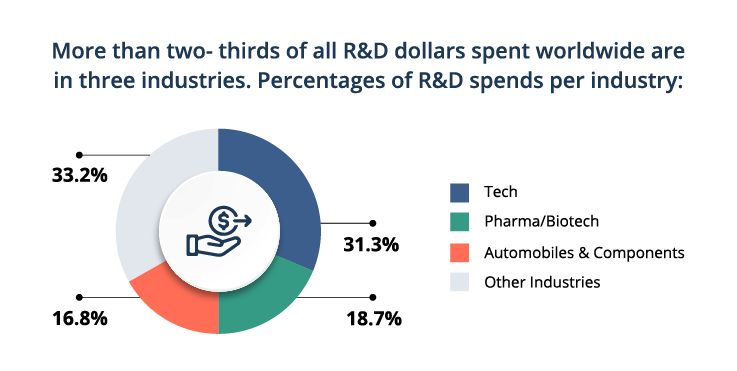
Since many are dedicated to research, the pharma and biotech sector tops all other companies concerning R&D as a percentage of sales.
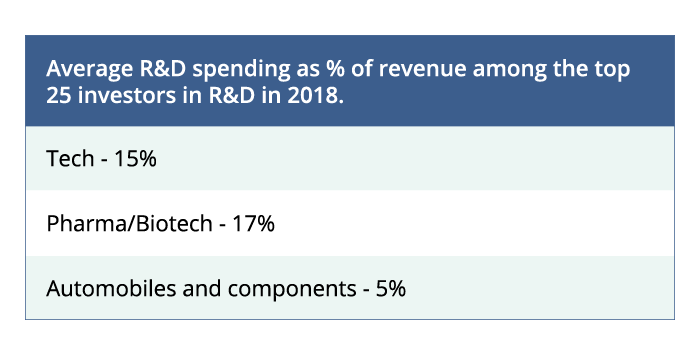
- On average, Pharma/Biotech companies invested about 17% of their annual revenue in R&D
- Tech companies invested about 15% in R&D
- Companies in the Auto industry invested about 5% of sales in R&D
How Do You Succeed with Make-Or-Buy Decisions?
One of the persistent questions in product development strategy for companies, as they scale, is how much they should depend on organic technology development vs. an M&A strategy.
Another way to ask the question is, how much should a company make vs. buy when it comes to new technologies? Should they use their existing development team or go outside for development? Or even invest further in a line of existing products? These questions and more are often part of a product development consulting engagement.
Making/Buying decisions involves many factors, but the main dimensions under consideration are the strategic value of the technology in question and the cost of producing it. In the matrix below, the X axis represents the investment cost required for the new technology. In contrast, the Y axis represents the degree of strategic value to the company. About strategic investment, ask: Is the technology you’re trying to make or buy vital to your company’s core product and future success? Rate its strategic value as low, medium, or high.
This yields a matrix with four quadrants as follows, with the default decision for technologies in each:
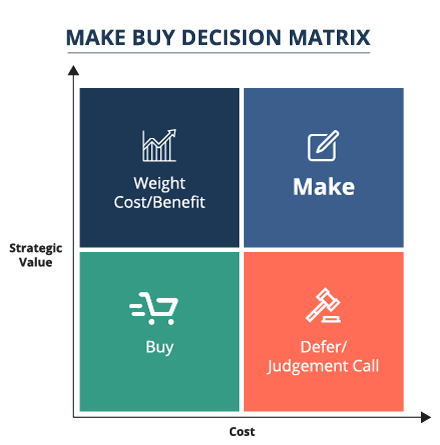
- High strategic value; high cost — Make
- High strategic value; low cost — Weigh Cost/Benefit
- Low strategic value, high cost — Defer or Judgment Call
- Low strategic value, low cost — Buy
This matrix is a simplified version of models created by BCG and GE-McKinsey. Many considerations go into a make/buy decision. Still, the most critical factors come down to the strategic value of the technology and the cost of developing it in-house with your development team.
Often, these decisions are made with the operations (or manufacturing) organizations and may be part of your New Product Introduction (NPI) process, which applies a manufacturing point of view to new product development.
How To Develop A Product Development Strategy

Aside from considering product development strategy consulting, a company must execute whatever product development strategy a company chooses. How do you develop and implement a new product strategy?
A viable product development strategy begins with the following:
- A vision: a broad statement of where you’d like your company to be (3-5-year horizon)
- A strategic plan for product development: steps you intend to take to achieve that vision (2-3-year horizon)
- Product and technology roadmaps, project priority lists, and budgets connected to specific programs that realize the strategy
A strategic product planning process links together the company’s vision, usually encompassing a three-to-five-year time horizon, with the strategic steps required over a one-to-two-year horizon to realize that vision.
It then connects the strategy to product and technology roadmaps – representations that allow decision-makers to see the progression of products and technologies and their changing relationships over time. These roadmaps then need to connect to the yearly budgeting process that prioritizes future products and provides them with the resources they need in their early stages.
Suppose your company does not have a clear way of guiding product concepts. In that case, the first step is to take your existing annual budgeting and business analysis processes and determine how planning for product innovation fits into it. The strategic product planning process comes after you formulate the overall strategic plan for the year but before you complete the budgeting.
Two yearly systems for the strategy process
To improve the planning and execution of a product development strategy, we advocate two systems:
- A yearly, systematic portfolio planning process tied to budgeting
- A monthly and ongoing portfolio management process for:
- a) selecting emerging product concepts aligned with the company’s strategy and
- b) prioritizing and initiating work on new product concepts.
The outputs from the yearly process become the inputs for an ongoing system that manages products to completion and launches them into the marketplace. Successful companies take control of their future by creating a tight link between their strategic direction and product concepts. What is at stake is the future of the company’s product portfolio. Often, this process includes decisions to stop producing existing products to free up development and support resources.
The two processes are linked but distinct. Strategy without ongoing management is ineffective while managing product concepts without adequate strategy and planning is often aimless and counterproductive. The system we advocate, with two related processes, supports planning with execution and increases the reliability of developing new products.
Having both a yearly strategic product planning cycle and an ongoing front-end management process is effective because product innovation and competitive threats can and do emerge at any time. Together, the two systems steer your company’s intent while providing a real-time approach to managing investments, ensuring readiness for development.
New Product Development Process (NPD)
The new product development process is the bridge between strategy and execution. Although many believe this is primarily product design, it also includes business factors that shape the product definition (before product design), such as product life cycle profitability (over the whole product lifetime). While NPD tends to focus on the current product under development, it also should include the impact on similar products in the product line as part of the product definition.
The most striking product innovations result from strategic planning and carefully nurturing innovative product ideas. And yet many organizations not only fail to have systematic tools or processes for dealing with both aspects of their future product portfolio – many insist that it is impossible to have any such system.
Conclusion: Five Tips for a Successful Product Development Strategy

Too long, didn’t read? Here are your five takeaways about product development strategy:
Tip #1: Innovate away from your core product. Consider the total user feedback and customer experience and find a way to be innovative that has nothing to do with the core product but produces an ancillary benefit. For example, FedEx beat UPS not because of planes, trains, and trucks. It was package tracking that put them over the edge. You can dominate markets on the augmented product and not only on the core product.
Tip #2: Find applications for existing products in new markets. For example, a gaming company might find a use for its platform by creating a game-based app that HR departments could use in screening applicants. Think of products that could succeed in adjacent markets.
Tip #3: Tie your corporate vision to product strategy and budgets. Create clean lines of sight between strategy, budgets, technologies, and products. Use road maps to show the route you will take to execute your product development strategy.
Tip #4: Managing a product portfolio requires a yearly process tied to R&D spending and budgeting and an ongoing, day-to-day process where an empowered team can push projects ahead until they are fully funded and supported.
Tip #5: Nurturing a steady stream of innovative new product ideas is crucial for driving long-term business growth. This requires proper governance, funding, and a proven process for vetting, selecting, and executing product development projects. By implementing a strong innovation pipeline, you can ensure a constant flow of new and improved offerings that cater to evolving customer needs and potentially unlock new markets, including the ever-growing world of e-commerce.
FAQ: Product Development Strategy
What is product development strategy?
A product development strategy guides new product development or existing product changes to maximize sales.
What are examples of product development strategy?
Examples of product development strategy include price strategy, innovation strategy, time to market, market/customer oriented, or platform strategy.
What are the stages of a product development strategy?
The stages of product development strategy include idea generation (Ideation), product road mapping (and selection), prototyping, designing, testing, and commercialization.

